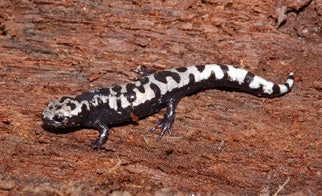SCIENTIFIC NAME:
Ambystoma opacum
OTHER NAMES:
Banded salamander.
STATUS:
Fairly common and similar to spotted salamander in distribution, habits, and habitat requirements. Low Conservation Concern.
DESCRIPTION:
The marbled salamander is three to five inches long. It has smooth, dark gray to black skin, with bold white (male) or silver-gray (female) cross-band markings on their upper surfaces. Markings are extremely variable, occasionally forming dorsolateral stripes or other patterns. Marbled salamanders have short stocky bodies, short broad heads and relatively short tails for salamanders - their tails comprise approximately 40% of their total length. They also have relatively short stocky legs; each foreleg has four toes while the hind legs have five toes each. Marbled salamanders have 11-13 costal grooves along the side of the body.
DISTRIBUTION:
Marbled salamanders are found from southern New England to northern Florida, west across eastern Texas and north through southeastern Oklahoma and southern Illinois. Disjunct populations are found near the southern perimeters of Lake Erie and Lake Michigan, as well as in southwestern Missouri and along the northern border between Ohio and Indiana. They occur statewide in Alabama.
HABITAT:
Marbled salamanders live in a variety of forest and woodland conditions ranging from moist sandy areas to dry hillsides, but never far from a moist environment. Flood plains and low hammocks are their preferred habitats. Adults spend most of their time in burrows, leaf litter or under rocks, bark or logs.
FEEDING HABITS:
Adult marbled salamanders eat a variety of invertebrates, including earthworms, slugs, snails, centipedes and a variety of insects. Larval marbled salamanders feed on zooplankton (tiny near microscopic aquatic animals). As the larvae grow they will gradually begin to feed on larger prey items such as tadpoles, insects and other amphibian larvae. Adults will remain dormant underground during dry conditions, but will feed during opportune times.
LIFE HISTORY AND ECOLOGY:
Marbled salamanders are solitary creatures except during the breeding season. Breeding in Alabama occurs during October and November. Unlike other members of the Family Ambystomatidae, the marbled salamander does not breed in the water. Adults gather in depressions on the forest floor beneath logs, leaf litter or other debris where they engage in courtship and mating. Males will deposit sperm packets called spermatophores on the ground. Interested females will pick up the spermatophores with their cloacal lips and inseminate their eggs. Females will lay 50 to 200 individual eggs in protected areas within the depressions. Females usually curl themselves around the eggs to keep them moist and guard them until rains flood the nest sites. If sufficient rains do not occur during the fall or early winter the larvae may not hatch until rains cover them in the spring. Eggs typically hatch within a day or two following being inundated. Marbled salamanders typically remain in the larval stage from four to six months. Their lifespan is approximately four years.
REFERENCES:
Mount, R. H., 1975. The Reptiles and Amphibians of Alabama. Ala. Agri. Expt. Sta., Auburn Univ., Auburn, AL. 347 pp.
New Hampshire Public Television 2006. “Marbled Salamander – Ambystoma opacum” (On-line). Accessed April 12, 2006 at http://nhptv.org/Natureworks/marbledsalamander.htm.
University of Georgia, Outreach Program of Savanah River Ecology Laboratory, 2001. “Marbled Salamander Fact Sheet.”
AUTHOR: Ron Eakes, Wildlife Biologist, Division of Wildlife and Freshwater Fisheries






